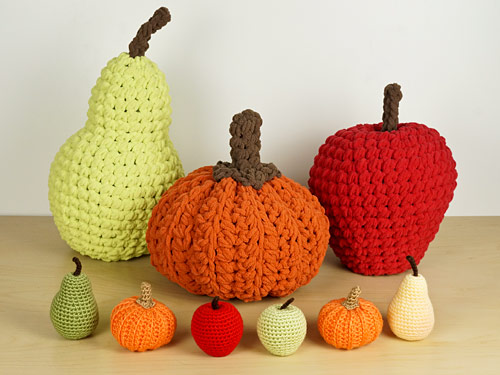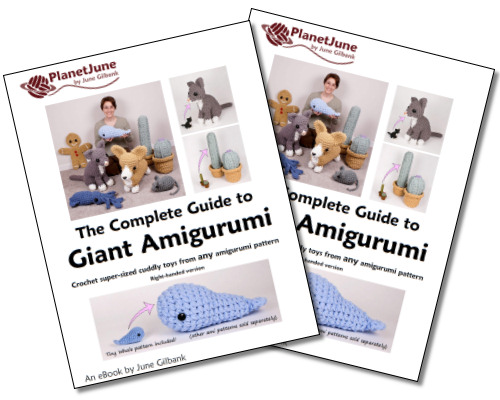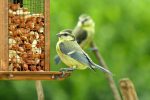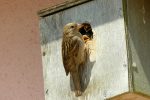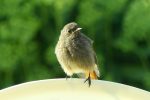If you’ve seen my new Eco-Friendly Cosmetic Rounds pattern, you may be wondering what type of yarn is best for making them.
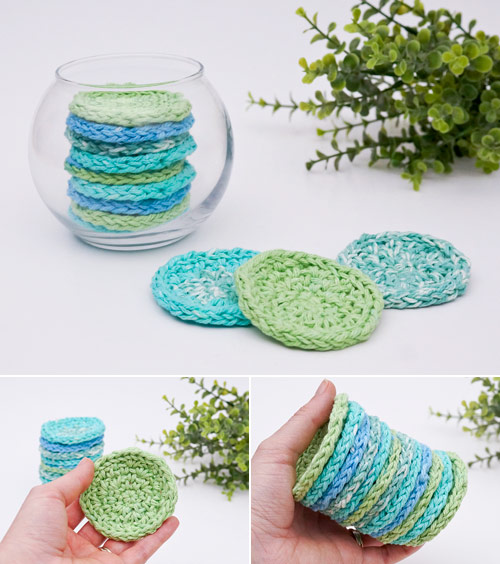
- Does it even matter?
- Will any cotton yarn scraps work equally well?
- Should you choose a yarn based solely on colour preference, or is there an advantage in using more expensive yarn, organic yarn, etc?
- Is mercerized cotton really a no-no?
- Are the cosmetic rounds really washable and reuseable, or will they look sad and ragged after a couple of uses?
I crocheted all the samples for my pattern using the same brand and type of yarn (Bernat Handicrafter) so I was wondering all those things, which means… it’s time for another PlanetJune investigation! 🙂
The Candidates
I raided my stash for a selection of cotton yarns for my comparison, and here’s what I chose:
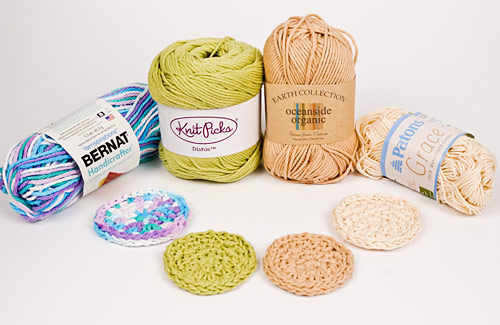
(Yarns and samples, left to right):
- Bernat Handicrafter (blue/purple), an inexpensive worsted weight kitchen cotton available from most craft stores (and the same type of yarn I used for my pattern samples)
- Knitpicks Dishie (green), a worsted weight cotton, with a smoother look and feel and tighter twist that makes it less splitty than everyday kitchen cottons
- Earth Collection Oceanside Organic (brown), a DK weight 100% organic cotton
- Patons Grace (cream), a sport weight mercerized* cotton (I held two strands together to approximate a worsted weight)
* I’ve read from several sources that the mercerization process improves the smoothness and sheen of a yarn, while reducing its absorbency, so I intentionally included a mercerized yarn sample in this test so we can see exactly how much less absorbent this yarn will be than the others!
I’ll refer to the samples by number from now on, and I’ll always arrange the samples 1-4 clockwise from top left, or in a straight line left to right.

I used the same hook and pattern for each sample, and you can see that there’s a difference in the size of the pads. Dishie (2) is much finer than Handicrafter (1) even though they are both supposedly worsted weight; it’s much closer to the DK-weight Oceanside (3). Holding two strands of Grace (4) together worked well to give me the right weight of yarn for the pattern (useful to know!)
Let’s look at each sample individually:
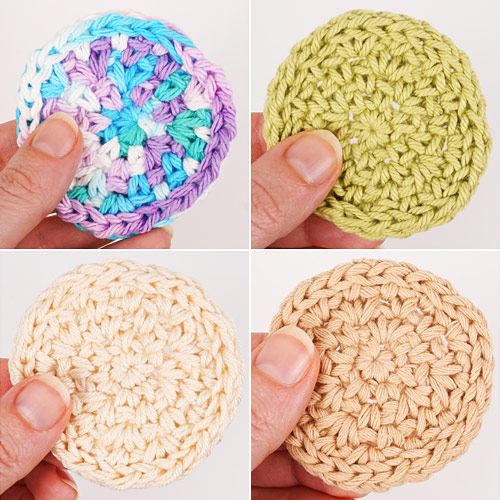
- I intentionally made my pattern samples using a ‘standard’ inexpensive kitchen cotton that should be widely available (there are several other comparable lines from other brands, e.g. Sugar ‘n Cream, Peaches and Creme). Some skeins can be a bit harsher-feeling and splittier than others, so I’d recommend you look for softer skeins if you have the option of touching them in-store. The resulting pads are nice and cushiony, without large holes between the stitches.
- As the Dishie is both finer and more tightly spun, you can see it left some gaps between the stitches. (If I made more, I might try going down a hook size to reduce the size of the holes.) The yarn didn’t split at all and the stitch definition is lovely, but the finished pad feels a little firm.
- Th organic cotton was very soft to work with, but extremely splitty. The finished pad is beautifully soft, though, so perhaps worth the frustration of trying not to split the strands while crocheting!
- The mercerized cotton is very smooth, with a nice sheen. The yarn felt firm and not at all splitty. The finished pad feels smooth and firm.
Absorbency Test
Okay, so we know how they look, but how well do they work? Time for an experiment!
I used a graduated pipette (yay, science!) so I could measure the same amount of water for each test:

For each sample, I squirted 0.6ml of tap water into the centre of the pad, and watched what happened.

- The water soaked in within a few seconds.
- The water sat on the surface for a surprisingly long time (about a minute) then soaked right through the pad.
- The water did not absorb at all – even after several minutes it was still sitting on top of the pad!
- The water soaked in immediately.
Yes, that’s right – the mercerized cotton, which I’d been led to believe would be less absorbent, was actually the most absorbent sample!
And the organic cotton, which I assumed would be very absorbent, was eerily waterproof.
I guessed that yarns 2 and 3 may have some fibre-processing treatment residue that was affecting their absorption rate, so I decided to re-run the absorbency test after washing and drying the samples, and see if that made a difference.
Washing Test
I put all 4 samples in a mesh laundry bag (this one is designed for washing bras, so it’s a nice compact size for washing a big batch of cosmetic rounds!) and ran them through the washer and dryer with my regular laundry.

How did they fare after the laundry cycle? Let’s see:

Not a lot of difference. Here are my observations on close examination:
- Fluffed up a bit on washing but also got considerably softer. (And, from my experience of using these for a few weeks now, they don’t look any worse after repeated washings than after the first wash.)
- Softened a bit on washing and didn’t fluff up.
- Fluffed slightly on washing. It was already very soft, so I don’t think it softened further.
- No difference at all – still smooth and firm.
Post-Wash Absorbency Test
I re-ran the absorbency test in exactly the same way as before, with 0.6ml of water dropped onto the centre of each pad.

- The water soaked in immediately.
- The water absorbed over a 5-second period and soaked right through the pad.
- The water still didn’t absorb at all. The only way I could get it to wet the pad was to rub the water around on the surface with my finger.
- The water soaked in immediately.
So, 1 and 2 became more absorbent after the wash, but 3 did not, and still seems highly water-repellent:

Here’s a close-up of 3 so you can (just about) see the big blob of water sitting on the surface of the middle of the pad (and clearly see a tiny droplet just to the left). I still can’t account for this behaviour – it was completely unexpected.

And here’s the big shocker – the completely soaked mercerized cotton.
Conclusions
Although the yarns did look and behave differently, any of them would work as cosmetic rounds – and I’ll be adding all these samples to my stack!
The yarns that started out smoother and with more lustre (2 and 4) looked closer to new after washing than the others, which had a little bit of fluffing up. However, fluffing is not necessarily a bad thing – the yarns that fluffed feel softer and less firm than the smoother yarns, and a little extra fluffiness actually makes them feel even softer.
And, most importantly: mercerized cotton is clearly not less absorbent than non-mercerized. I’ve removed that statement from my pattern, and I’ve since done further research and found a source that claims the mercerization process makes cotton more absorbent, which my test would support (although, without being able to test the same fibre pre- and post-mercerization, I can’t prove that definitively!)
Tips for Choosing Yarn
- As we know, yarns of the same weight (e.g. ‘worsted weight’) are not all exactly the same thickness – see my worsted weight yarn comparison for proof! Different yarns will give you slightly differently-sized rounds, so if you want to crochet a matched set with some variation, I’d suggest sticking to the same yarn line and just swapping colours (or choose a striped yarn so you get multiple colours from one ball!)
- For sample 1, I used a variegated skein of Bernat Handicrafter in Beachball Blue, instead of the striped colourways I chose for the pattern samples. I found the resulting mishmash of colours to be a bit busy for my taste, with a colour change every couple of stitches, but you may love this effect! Every pad will look different, but still co-ordinated, if you make them with a yarn like this.
- Does appearance or softness matter more to you? I prefer the feel of the fluffier, softer cottons (after the first wash) to the smoother, firmer yarns. So I’ll be sticking with the basic kitchen cotton for my rounds, even though I prefer the look of the stitch definition of the smoother yarns.
- As evidenced by my absorbency tests, some yarns may not behave exactly as you expect! So, if you’re unsure about a yarn, I suggest you try making a single pad with it, using it, washing it and using it again. That’ll give you the best gauge as to how well the yarn will do the job, and whether it will fluff up, soften up and/or become more absorbent after washing it. I’d recommend you do this before you make a whole batch from the same yarn, especially if you plan to give them as gifts!
- Having said that, you can probably make effective cosmetic rounds from pretty much any cotton or cotton-blend yarn. Pull out some cotton scraps and have a go!
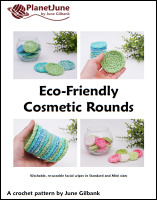
If you’d like to make some Eco-Friendly Cosmetic Rounds, you can find the free online version of the pattern here.
Or, send me a donation and receive the easy-to-print PDF version of the pattern as a thank you! The PDF version also includes some bonuses (the pattern for the Mini size rounds – perfect for applying toner – and additional instructional photos and tips, including left-handed photos).
Do you have any experience with cotton yarns? Please share your recommendations for your favourites – or warnings for your least favourites! – in the comments below…

